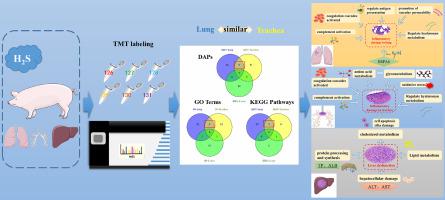Science of the Total Environment ( IF 9.8 ) Pub Date : 2021-09-16 , DOI: 10.1016/j.scitotenv.2021.150365 Zhen Liu 1 , Liang Chen 2 , Xin Gao 3 , Ruixia Zou 4 , Qingshi Meng 2 , Qin Fu 5 , Yanjiao Xie 2 , Qixiang Miao 2 , Lei Chen 2 , Xiangfang Tang 2 , Sheng Zhang 5 , Hongfu Zhang 2 , Martine Schroyen 6

|
Hydrogen sulfide (H2S) is a highly toxic gas in many environmental and occupational places. It can induce multiple organ injuries particularly in lung, trachea and liver, but the relevant mechanisms remain poorly understood. In this study, we used a TMT-based discovery proteomics to identify key proteins and correlated molecular pathways involved in the pathogenesis of acute H2S-induced toxicity in porcine lung, trachea and liver tissues. Pigs were subjected to acute inhalation exposure of up to 250 ppm of H2S for 5 h for the first time. Changes in hematology and biochemical indexes, serum inflammatory cytokines and histopathology demonstrated that acute H2S exposure induced organs inflammatory injury and dysfunction in the porcine lung, trachea and liver. The proteomic data showed 51, 99 and 84 proteins that were significantly altered in lung, trachea and liver, respectively. Gene ontology (GO) annotation, KEGG pathway and protein-protein interaction (PPI) network analysis revealed that acute H2S exposure affected the three organs via different mechanisms that were relatively similar between lung and trachea. Further analysis showed that acute H2S exposure caused inflammatory damages in the porcine lung and trachea through activating complement and coagulation cascades, and regulating the hyaluronan metabolic process. Whereas antigen presentation was found in the lung but oxidative stress and cell apoptosis was observed exclusively in the trachea. In the liver, an induced dysfunction was associated with protein processing in the endoplasmic reticulum and lipid metabolism. Further validation of some H2S responsive proteins using western blotting indicated that our proteomics data were highly reliable. Collectively, these findings provide insight into toxic molecular mechanisms that could potentially be targeted for therapeutic intervention for acute H2S intoxication.
中文翻译:

定量蛋白质组学揭示硫化氢引起猪不同器官急性损伤的组织特异性毒性机制
硫化氢 (H 2 S) 在许多环境和职业场所是一种剧毒气体。它可以引起多器官损伤,尤其是肺、气管和肝脏,但相关机制仍知之甚少。在这项研究中,我们使用基于 TMT 的发现蛋白质组学来鉴定与 H 2 S 诱导的猪肺、气管和肝组织急性毒性发病机制相关的关键蛋白质和相关分子途径。猪第一次经受高达 250 ppm H 2 S 的急性吸入暴露5 小时。血液学和生化指标、血清炎性细胞因子和组织病理学的变化表明,急性 H 2S 暴露导致猪肺、气管和肝脏器官炎症损伤和功能障碍。蛋白质组学数据显示,肺、气管和肝脏中分别有 51、99 和 84 种蛋白质发生了显着改变。基因本体(GO)注释、KEGG通路和蛋白质-蛋白质相互作用(PPI)网络分析表明,急性H 2 S暴露通过肺和气管之间相对相似的不同机制影响三个器官。进一步分析表明,急性 H 2S 暴露通过激活补体和凝血级联反应,调节透明质酸代谢过程,引起猪肺和气管的炎症损伤。而在肺中发现抗原呈递,但仅在气管中观察到氧化应激和细胞凋亡。在肝脏中,诱导的功能障碍与内质网中的蛋白质加工和脂质代谢有关。使用蛋白质印迹进一步验证一些 H 2 S 响应蛋白表明我们的蛋白质组学数据高度可靠。总的来说,这些发现提供了对毒性分子机制的深入了解,这些机制可能成为急性 H 2 S 中毒治疗干预的目标。


























 京公网安备 11010802027423号
京公网安备 11010802027423号